Painting of the former Caerphilly Miners' Hospital 1923-2011
(2007/14)
Prints are available - sizes 1, 11 and 10. Click HERE
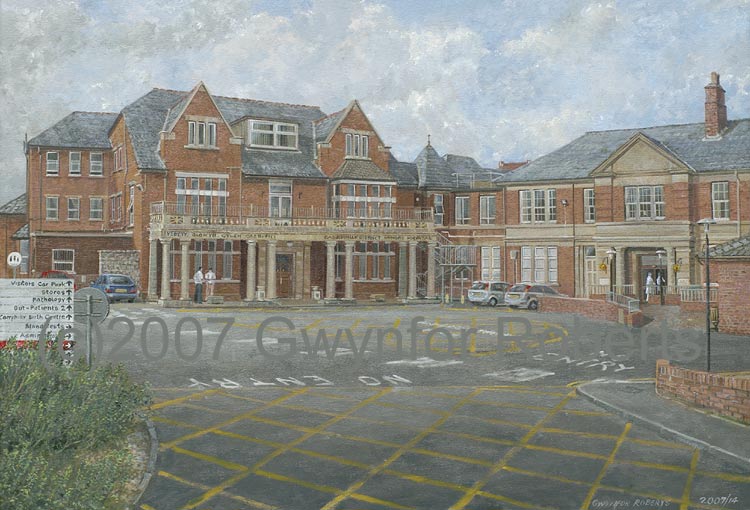
Oil painting of Caerphilly Miners' Hospital.
This painting of 'Caerphilly Miners' Hospital' is the view as you drive towards the main entrace. From the little knowledge
I have of the hospital I know that it was built for the miners and they themselves contributed to the building - a lot to ask
for in those days.
Huge changes are in the pipeline for this area. The new Ystrad Fawr Hospital in Ystrad Mynach is due to open in late 2011 and it will be interesting
to see what becomes of the historical Miners' Hospital.
Lots of people ask if I use a pencil to draw the landscape before painting. The answer to this is no, it's all done with
brush work.
Two people have been kind enough to send in historical details of the Hospital - lots to read below.
Here is a letter I received from a lady who describes the life of her great grandfather - Alderman Hubert Jenkins of Abertridwr
(opposite) - and his contribution to the Miners' Hospital.
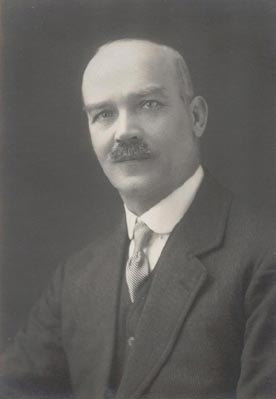 'In South Wales I've been undertaking some genealogy for a number of years but have only recently started to flesh out the
detail and get photographs of the people, and places to include with my family tree reports. More recently I've been looking for
photographs relating to my fathers family and hope to give him my reports as an extra Christmas present. I have gathered some
information from newspaper clippings etc on my great grandfather - Alderman Hubert Jenkins of Abertridwr. He was born in Ross,
nr Hereford in 1866 and his mining career started from the age of 13yrs where he worked stoking and underground in the Wigpool Iron
Mines in Forest of Dean. During his lifetime he worked in many mines within the South Wales coalfield and for almost 3 year worked
in mines in the states of Pennsylvania and Ohio before returning to again work in the South Wales mines. I have a couple of pages
Biography on him but have only picked out salient points for you on the reasons behind his involvement in the setting up the hospital.
'In South Wales I've been undertaking some genealogy for a number of years but have only recently started to flesh out the
detail and get photographs of the people, and places to include with my family tree reports. More recently I've been looking for
photographs relating to my fathers family and hope to give him my reports as an extra Christmas present. I have gathered some
information from newspaper clippings etc on my great grandfather - Alderman Hubert Jenkins of Abertridwr. He was born in Ross,
nr Hereford in 1866 and his mining career started from the age of 13yrs where he worked stoking and underground in the Wigpool Iron
Mines in Forest of Dean. During his lifetime he worked in many mines within the South Wales coalfield and for almost 3 year worked
in mines in the states of Pennsylvania and Ohio before returning to again work in the South Wales mines. I have a couple of pages
Biography on him but have only picked out salient points for you on the reasons behind his involvement in the setting up the hospital.
He was a leading figure on behalf of the South Wales Miners Federation (SWMF) in the inquiry into the disastrous explosion at
Senghenydd on Tuesday 14 October 1913 when 439 lost their lives. Like most families in Senghenydd we also had a relative who died
in the explosion. Being District and Area secretary, following the explosion he dealt with more than 400 claims in addition to the
ordinary number of claims. 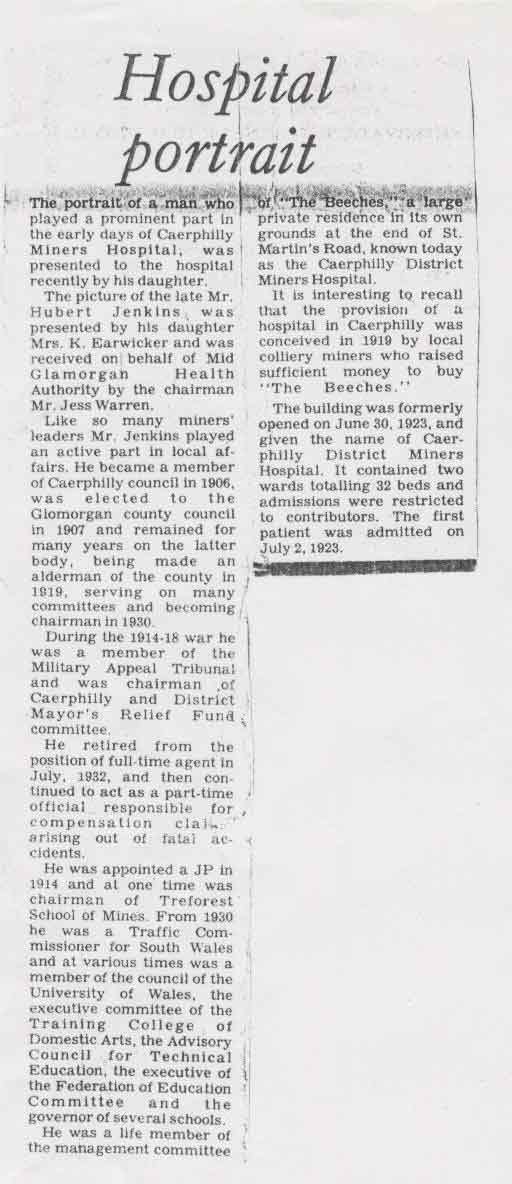 During the time that he was a miners agent he also gave evidence before the Royal Commission on Accidents
in Mines, served on the Safety Lamps Commission etc. He held a various number of positions throughout the years both in mining and
in public office i.e. Councillor, Chairman of Glamorgan CC, Chairman of Caerphilly Urban Council, Assistant Traffic Commissioner of
South Wales area, Justice of the Peace and later was given the title of 'Alderman' of the county.
During the time that he was a miners agent he also gave evidence before the Royal Commission on Accidents
in Mines, served on the Safety Lamps Commission etc. He held a various number of positions throughout the years both in mining and
in public office i.e. Councillor, Chairman of Glamorgan CC, Chairman of Caerphilly Urban Council, Assistant Traffic Commissioner of
South Wales area, Justice of the Peace and later was given the title of 'Alderman' of the county.
Here is a letter I received from a lady who describes the life of her great grandfather - Alderman Hubert Jenkins of Abertridwr - and
his contribution to the Miners' Hospital.
His father William had lost his left arm in a mining incident many years before thus influencing Hubert's later career as a mining
agent, trade unionist and his dedication to helping form the Caerphilly Miners Hospital. Many years back when his daughter
Catherine (my grandmother) was alive she presented a portrait of him to the miners hospital, though I'm not sure if it is still there.
A newspaper article written at the time (either late 70's or early 80's) about the presentation states:
"He was a life member of the management committee of the "The Beeches" a large private residence in its own grounds at the end of
St Martins Road, know today as the Caerphilly District Miners Hospital. It is interesting to recall that the provision of a hospital
in Caerphilly was conceived in 1919 by local colliery miners who raised sufficient money to buy "The Beeches. The building was
formerly opened on June 30 1923 and given the name Caerphilly District Miners Hospital, it contained two wards totalling 32 beds and
admissions were restricted to contributors. The first patient was admitted on July 2, 1923.
In an article on his life (in some book on mining I have somewhere) I found the following information:
"Acting on behalf of East Glamorgan District Miners Executive Hubert Jenkins (of Abertridwr) and Henry Richards (of Bedwas) were
responsible for negotiating the purchase of the "Beeches" to be used as a miners hospital. "The Beeches" is described as a 'Miners
Convalescent Home' of which he was a lifetime member of the management committee. So I assume that this is how the hospital started
life.
Whilst trying to seek a photograph of the miners hospital I came across your beautiful painting on the web. Amazingly despite having
grown up and worked in South Wales for the first part of my life (prior to moving to Cheshire) and often visiting relatives in
Abertridwr and Senghenydd I have never been to see the hospital. Now that I'm back living do intend to this soon as long as the
hospital is still standing, but meanwhile I'm very pleased to have seen your painting and will have great delight in showing it
to my father at Christmas. I hope the above is of some small interest to you. '
------------------------------------------------------------------------------------------------------------------
July 2010. More history of the Miners'Hospital.
Our Thanks to Mr Haydn Fletcher for sending this in.
Please find attached information you may find interesting with respect to the opening of the Caerphilly Miners' Hospital. It was
my grandfather John (Jack) Phillips who opened the hospital. I have attached photographs of my grandfather, the key he used to open
the hospital and a photograph taken on the day the hospital was opened (not a very good one I am afraid). I've also included some
information about his life. There used to be a large photograph of my grandfather actually opening the hospital on the wall in his
house, but this was lost to the family many years ago. I have copies of "The Express" and the "Caerphilly Journal" newspapers for
Saturday, July 7, 1923 (obtained from the Newspaper Library in London), which cover the opening of the hospital in great detail.
However, it would not be practical to try and photo copy them for transmission as an attachment to an e-mail.
Regards,
Haydn Fletcher.
The information from Mr Fletcher is below:
My maternal grandfather was John (Jack) Phillips. In 1923 he was a County Councillor and chairman of the Caerphilly and District
Hospital Committee.
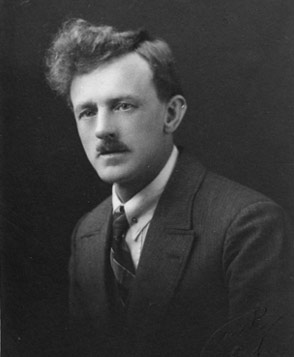 It was he who opened the Caerphilly Miners’ Hospital. The key he used to
open the Hospital is still with the family. On three sides of the shaft is engraved the following: "PRESENTED TO Mr JOHN PHILLIPS,
C.C AT THE OPENING OF THE HOSPITAL 30th JUNE 1923".
It was he who opened the Caerphilly Miners’ Hospital. The key he used to
open the Hospital is still with the family. On three sides of the shaft is engraved the following: "PRESENTED TO Mr JOHN PHILLIPS,
C.C AT THE OPENING OF THE HOSPITAL 30th JUNE 1923".
He was one of the best-known men in the Labour movement at that time and over a 17 year period occupied many prominent positions in
connection with the South Wales Miners' Federation. He had been chairman of the Penallta Lodge and of the East Glamorgan District,
and had represented both at conferences and trade union conferences. He was the first chairman of the governors of the Caerphilly
Miners' Hospital, a member of the Caerphilly School Managers and a member of the Court of Referees for the Rhymney Valley. He was
the first man to represent Nelson Ward in the Labour interest on the Caerphilly Council of which he was a member for three years.
In 1922 he secured election to the Glamorgan County Council by a sensational victory over Colonel Lindsay of Ystrad Mynach. In 1925
he was made an Alderman. He was also on the committee responsible for the erection of the Nelson War Memorial, which was unveiled
on the 26th August 1926. He was a vigorous platform speaker and "a man of integrity".
During the 1926 strike he addressed a number of meetings in the Midlands speaking on behalf of the miners. Prior to the strike he was
a checkweigher at the Penallta Colliery. However, following the strike he was not reinstated as the company had introduced the
conveyor system. He was eventually offered a job as a school attendance officer under the Penarth Group of School Managers, which
necessitated his resigning his seat as a county aldermen. The family firmly believe that this situation was created deliberately
by the colliery owners in order to remove him from his influential position on the Council, where he was seen as a threat to the
status quo. He died on the 13th September 1949.
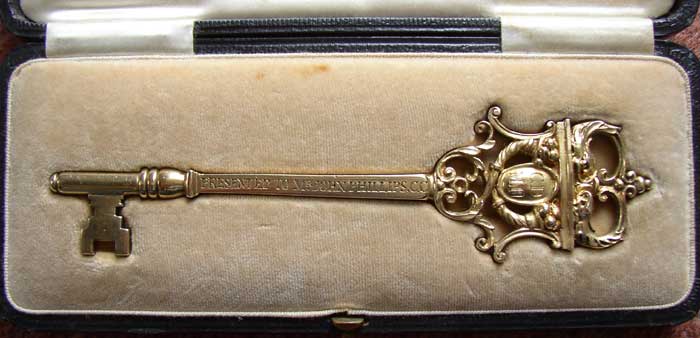
Welsh Heritage-History of Caerphilly Miners' Hospital
Closed Hospitals
County of Caerphilly
Home
Contact
About
Prints of Wales
sketch book
County Borough of Caerphilly, Wales
latest paintings of Wales
Other paintings of Wales
Table mats
Trains and stations
Paintings of properties
Paintings of West Wales
Paintings of North Wales
Chapels and Churches in Wales
Miniature prints of Wales
Tour of Britain cycle race - 2011.
Tour of Britain cycle race - 2012.
Paintings outside Wales.
This site is Copyright
Welsh Artist Gwynfor Roberts estate
Huge changes are in the pipeline for this area. The new Ystrad Fawr Hospital in Ystrad Mynach is due to open in late 2011 and it will be interesting to see what becomes of the historical Miners' Hospital. Lots of people ask if I use a pencil to draw the landscape before painting. The answer to this is no, it's all done with brush work.
Here is a letter I received from a lady who describes the life of her great grandfather - Alderman Hubert Jenkins of Abertridwr (opposite) - and his contribution to the Miners' Hospital.
 'In South Wales I've been undertaking some genealogy for a number of years but have only recently started to flesh out the
detail and get photographs of the people, and places to include with my family tree reports. More recently I've been looking for
photographs relating to my fathers family and hope to give him my reports as an extra Christmas present. I have gathered some
information from newspaper clippings etc on my great grandfather - Alderman Hubert Jenkins of Abertridwr. He was born in Ross,
nr Hereford in 1866 and his mining career started from the age of 13yrs where he worked stoking and underground in the Wigpool Iron
Mines in Forest of Dean. During his lifetime he worked in many mines within the South Wales coalfield and for almost 3 year worked
in mines in the states of Pennsylvania and Ohio before returning to again work in the South Wales mines. I have a couple of pages
Biography on him but have only picked out salient points for you on the reasons behind his involvement in the setting up the hospital.
'In South Wales I've been undertaking some genealogy for a number of years but have only recently started to flesh out the
detail and get photographs of the people, and places to include with my family tree reports. More recently I've been looking for
photographs relating to my fathers family and hope to give him my reports as an extra Christmas present. I have gathered some
information from newspaper clippings etc on my great grandfather - Alderman Hubert Jenkins of Abertridwr. He was born in Ross,
nr Hereford in 1866 and his mining career started from the age of 13yrs where he worked stoking and underground in the Wigpool Iron
Mines in Forest of Dean. During his lifetime he worked in many mines within the South Wales coalfield and for almost 3 year worked
in mines in the states of Pennsylvania and Ohio before returning to again work in the South Wales mines. I have a couple of pages
Biography on him but have only picked out salient points for you on the reasons behind his involvement in the setting up the hospital.
He was a leading figure on behalf of the South Wales Miners Federation (SWMF) in the inquiry into the disastrous explosion at Senghenydd on Tuesday 14 October 1913 when 439 lost their lives. Like most families in Senghenydd we also had a relative who died in the explosion. Being District and Area secretary, following the explosion he dealt with more than 400 claims in addition to the ordinary number of claims.
 During the time that he was a miners agent he also gave evidence before the Royal Commission on Accidents
in Mines, served on the Safety Lamps Commission etc. He held a various number of positions throughout the years both in mining and
in public office i.e. Councillor, Chairman of Glamorgan CC, Chairman of Caerphilly Urban Council, Assistant Traffic Commissioner of
South Wales area, Justice of the Peace and later was given the title of 'Alderman' of the county.
During the time that he was a miners agent he also gave evidence before the Royal Commission on Accidents
in Mines, served on the Safety Lamps Commission etc. He held a various number of positions throughout the years both in mining and
in public office i.e. Councillor, Chairman of Glamorgan CC, Chairman of Caerphilly Urban Council, Assistant Traffic Commissioner of
South Wales area, Justice of the Peace and later was given the title of 'Alderman' of the county.
Here is a letter I received from a lady who describes the life of her great grandfather - Alderman Hubert Jenkins of Abertridwr - and his contribution to the Miners' Hospital.
His father William had lost his left arm in a mining incident many years before thus influencing Hubert's later career as a mining agent, trade unionist and his dedication to helping form the Caerphilly Miners Hospital. Many years back when his daughter Catherine (my grandmother) was alive she presented a portrait of him to the miners hospital, though I'm not sure if it is still there.
A newspaper article written at the time (either late 70's or early 80's) about the presentation states: "He was a life member of the management committee of the "The Beeches" a large private residence in its own grounds at the end of St Martins Road, know today as the Caerphilly District Miners Hospital. It is interesting to recall that the provision of a hospital in Caerphilly was conceived in 1919 by local colliery miners who raised sufficient money to buy "The Beeches. The building was formerly opened on June 30 1923 and given the name Caerphilly District Miners Hospital, it contained two wards totalling 32 beds and admissions were restricted to contributors. The first patient was admitted on July 2, 1923.
In an article on his life (in some book on mining I have somewhere) I found the following information:
"Acting on behalf of East Glamorgan District Miners Executive Hubert Jenkins (of Abertridwr) and Henry Richards (of Bedwas) were responsible for negotiating the purchase of the "Beeches" to be used as a miners hospital. "The Beeches" is described as a 'Miners Convalescent Home' of which he was a lifetime member of the management committee. So I assume that this is how the hospital started life.
Whilst trying to seek a photograph of the miners hospital I came across your beautiful painting on the web. Amazingly despite having grown up and worked in South Wales for the first part of my life (prior to moving to Cheshire) and often visiting relatives in Abertridwr and Senghenydd I have never been to see the hospital. Now that I'm back living do intend to this soon as long as the hospital is still standing, but meanwhile I'm very pleased to have seen your painting and will have great delight in showing it to my father at Christmas. I hope the above is of some small interest to you. '
------------------------------------------------------------------------------------------------------------------
July 2010. More history of the Miners'Hospital.
Our Thanks to Mr Haydn Fletcher for sending this in.
Please find attached information you may find interesting with respect to the opening of the Caerphilly Miners' Hospital. It was my grandfather John (Jack) Phillips who opened the hospital. I have attached photographs of my grandfather, the key he used to open the hospital and a photograph taken on the day the hospital was opened (not a very good one I am afraid). I've also included some information about his life. There used to be a large photograph of my grandfather actually opening the hospital on the wall in his house, but this was lost to the family many years ago. I have copies of "The Express" and the "Caerphilly Journal" newspapers for Saturday, July 7, 1923 (obtained from the Newspaper Library in London), which cover the opening of the hospital in great detail. However, it would not be practical to try and photo copy them for transmission as an attachment to an e-mail.
Regards,
Haydn Fletcher.
The information from Mr Fletcher is below:
My maternal grandfather was John (Jack) Phillips. In 1923 he was a County Councillor and chairman of the Caerphilly and District Hospital Committee.
 It was he who opened the Caerphilly Miners’ Hospital. The key he used to
open the Hospital is still with the family. On three sides of the shaft is engraved the following: "PRESENTED TO Mr JOHN PHILLIPS,
C.C AT THE OPENING OF THE HOSPITAL 30th JUNE 1923".
It was he who opened the Caerphilly Miners’ Hospital. The key he used to
open the Hospital is still with the family. On three sides of the shaft is engraved the following: "PRESENTED TO Mr JOHN PHILLIPS,
C.C AT THE OPENING OF THE HOSPITAL 30th JUNE 1923".
He was one of the best-known men in the Labour movement at that time and over a 17 year period occupied many prominent positions in connection with the South Wales Miners' Federation. He had been chairman of the Penallta Lodge and of the East Glamorgan District, and had represented both at conferences and trade union conferences. He was the first chairman of the governors of the Caerphilly Miners' Hospital, a member of the Caerphilly School Managers and a member of the Court of Referees for the Rhymney Valley. He was the first man to represent Nelson Ward in the Labour interest on the Caerphilly Council of which he was a member for three years. In 1922 he secured election to the Glamorgan County Council by a sensational victory over Colonel Lindsay of Ystrad Mynach. In 1925 he was made an Alderman. He was also on the committee responsible for the erection of the Nelson War Memorial, which was unveiled on the 26th August 1926. He was a vigorous platform speaker and "a man of integrity".
During the 1926 strike he addressed a number of meetings in the Midlands speaking on behalf of the miners. Prior to the strike he was a checkweigher at the Penallta Colliery. However, following the strike he was not reinstated as the company had introduced the conveyor system. He was eventually offered a job as a school attendance officer under the Penarth Group of School Managers, which necessitated his resigning his seat as a county aldermen. The family firmly believe that this situation was created deliberately by the colliery owners in order to remove him from his influential position on the Council, where he was seen as a threat to the status quo. He died on the 13th September 1949.